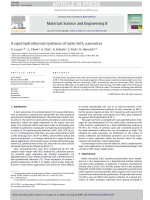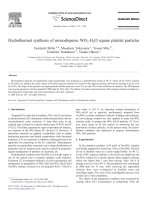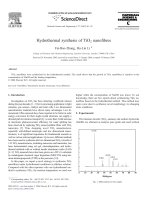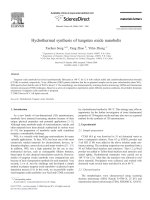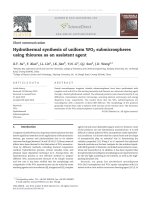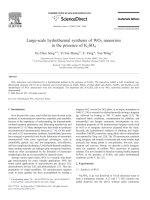controllable hydrothermal synthesis of zno nanowires arrays on al-doped zno
Bạn đang xem bản rút gọn của tài liệu. Xem và tải ngay bản đầy đủ của tài liệu tại đây (1.85 MB, 7 trang )
Applied
Surface
Science
257 (2011) 10134–
10140
Contents
lists
available
at
ScienceDirect
Applied
Surface
Science
jou
rn
al
h
om
epa
g
e:
www.elsevier.com/locate/apsusc
Controllable
hydrothermal
synthesis
of
ZnO
nanowires
arrays
on
Al-doped
ZnO
seed
layer
and
patterning
of
ZnO
nanowires
arrays
via
surface
modification
of
substrate
Jin
Zhang
a
,
Wenxiu
Que
a,∗
,
Qiaoying
Jia
a
,
Xiangdong
Ye
b
,
Yucheng
Ding
b
a
Electronic
Materials
Research
Laboratory,
School
of
Electronic
and
Information
Engineering,
Xi’an
Jiaotong
University,
Xi’an
710049,
Shaanxi,
People’s
Republic
of
China
b
State
Key
Laboratory
of
Manufacturing
Systems
Engineering,
Xi’an
Jiaotong
University,
Xi’an
710049,
Shaanxi,
People’s
Republic
of
China
a
r
t
i
c
l
e
i
n
f
o
Article
history:
Received
11
December
2010
Received
in
revised
form
7
June
2011
Accepted
10
June
2011
Available online 7 July 2011
Keywords:
Zinc
oxide
Nanowires
Seed
layer
Fluorination
Photoluminescence
a
b
s
t
r
a
c
t
ZnO
nanowire
(NW)
arrays
are
assembled
on
the
Al-doped
ZnO
(AZO)
seed
layer
by
a
hydrothermal
process.
Effects
of
the
temperature
and
growth
time
of
the
hydrothermal
process
on
morphological
and
photoluminescence
properties
of
the
as-assembled
ZnO
NW
arrays
are
characterized
and
studied.
Results
indicate
that
the
length
and
diameter
of
the
ZnO
NWs
increase
with
a
lengthening
of
the
growth
time
at
80
◦
C
and
the
hydrothermal
temperature
has
a
significant
effect
on
the
growth
rate
and
the
photo-
luminescence
properties
of
the
ZnO
NW
arrays.
The
patterned
AZO
seed
layer
is
fabricated
on
a
silicon
substrate
by
combining
a
sol–gel
process
with
an
electron-beam
lithography
process,
as
well
as
a
surface
fluorination
technique,
and
then
the
ZnO
NW
arrays
are
selectively
grown
on
those
patterned
regions
of
the
AZO
seed
layer
by
the
hydrothermal
process.
Room-temperature
photoluminescence
spectra
of
the
patterned
ZnO
NW
arrays
shows
that
only
a
strong
UV
emission
at
about
380
nm
is
observed,
which
implies
that
few
crystal
defects
exist
inside
the
as-grown
ZnO
NW
arrays.
© 2011 Elsevier B.V. All rights reserved.
1.
Introduction
ZnO
is
a
semiconductor
with
exceptional
electronic
and
pho-
tonic
properties
as
well
as
great
thermal
stability
and
oxidation
resistance.
Recent
developments
and
capacity
to
synthesize
ZnO
nanostructures
with
different
shapes
[1–3]
have
led
to
novel
and
enhanced
properties
as
compared
to
its
bulk
form,
and
thus
enabling
it
to
have
many
attractive
applications.
For
example,
it
can
be
used
as
a
potential
material
for
nanodevice
assembly
and
applications
in
blue-UV
light
emitters
[4]
and
photodetectors
[5],
field
emission
devices
[6],
and
dye-sensitized
solar
cells
[7],
etc.
Indeed,
well-aligned
ZnO
nanowire
(NW)
arrays
have
been
formed
on
GaN,
AlN,
Al
1−x
Ga
x
N,
6H–SiC,
and
ZnO
buffer
layers
[8–10],
but
the
optical
properties
of
the
NWs
grown
on
buffer
layers
have
been
scarcely
investigated,
especially
with
respect
to
impurity
and
defect
distribution,
which
can
hinder
the
applications
of
the
NW
arrays.
In
recent
years,
a
number
of
the
ZnO
thin
films
doped
with
various
metallic
ions
have
been
extensively
studied
for
the
manipulation
of
their
optical
and
electrical
properties,
the
Al-doped
ZnO
(AZO)
thin
films
are
attractive
due
to
their
good
conductivity,
high
trans-
∗
Corresponding
author.
Tel.:
+86
29
82668679;
fax:
+86
29
82668794.
address:
(W.
Que).
parency
and
relatively
low
cost
[11,12].
In
view
of
this,
the
use
of
a
lattice-matched
and
conducting
buffer
layer
may
circumvent
the
problem
and
lead
to
potential
integration
with
silicon
micro-
electronics
[13–15].
Therefore,
the
luminescent
and
electron
field
emission
properties
of
the
ZnO
NW
arrays
grown
on
the
AZO
seed
layers
are
also
reported
by
many
research
groups
[16,17].
Further-
more,
in
order
to
achieve
an
immense
potential
of
the
ZnO
NW
arrays,
it
is
important
and
necessary
to
have
a
good
control
for
the
spatial
arrangements
and
properties
of
the
ZnO
NW
arrays
[16].
In
this
paper,
the
ZnO
NW
arrays
were
grown
on
AZO
seed
layer,
which
was
deposited
by
a
sol–gel
process,
by
a
hydrother-
mal
method,
and
effects
of
the
temperature
and
growth
time
of
the
hydrothermal
process
on
the
morphological
and
photolumines-
cence
properties
of
the
as-grown
ZnO
NW
arrays
were
also
studied
and
discussed.
In
addition,
what
we
believe
to
be
the
first
report
on
the
fabrication
of
the
patterned
AZO
seed
layer
on
the
silicon
substrate
by
combining
a
sol–gel
process
with
an
electron-beam
lithography
process,
as
well
as
a
surface
fluorination
technique,
which
can
eliminate
the
effect
of
the
electron-beam
resist
on
the
boundary
of
the
patterned
AZO
seed
layer,
and
thus
the
ZnO
NW
arrays
could
be
successfully
grown
on
the
patterned
regions
of
the
AZO
seed
layer
by
employing
the
hydrothermal
process.
Further-
more,
the
photoluminescene
properties
of
the
selectively
grown
ZnO
NW
arrays
were
also
characterized
and
investigated.
0169-4332/$
–
see
front
matter ©
2011 Elsevier B.V. All rights reserved.
doi:10.1016/j.apsusc.2011.06.163
J.
Zhang
et
al.
/
Applied
Surface
Science
257 (2011) 10134–
10140 10135
Fig.
1.
Schematic
representation
of
the
patterning
process
of
the
ZnO
NW
arrays
on
silicon
substrate.
2.
Experimental
2.1.
Preparation
of
the
AZO
seed
layer
In
order
to
compare
the
properties
of
the
ZnO
NW
arrays
grown
on
different
seed
layers,
the
ZnO
and
AZO
seed
layers
were
pre-
pared
by
the
sol–gel
technique.
Here,
the
Al-doped
concentration
of
the
AZO
seed
layer
was
1.0
at.%
with
respect
to
Zn
due
to
its
relatively
outstanding
performance
than
other
doping
concentra-
tions
as
shown
in
our
previous
report
[18].
The
ZnO
and
AZO
sols
were
prepared
as
follows.
In
briefly,
Zn(CH
3
COO)
2
·2H
2
O
was
first
dissolved
in
a
2-methoxyethanol
monoethanolamine
(MEA)-
deionized
water
solution
at
room
temperature.
The
molar
ratio
of
the
MEA
and
deionized
water
to
zinc
acetate
was
fixed
at
1
and
0.5,
respectively,
and
the
concentration
of
the
zinc
acetate
was
0.75
mol/L.
For
the
AZO
sol,
an
appropriate
amount
of
alu-
minum
doping
was
obtained
by
adding
AlCl
3
·6H
2
O
to
above
the
as-prepared
precursor
solution.
Then,
the
final
solution
was
stirred
at
60
◦
C
for
30
min
until
to
yield
a
clear
and
homogeneous
solution.
The
ZnO
and
AZO
seed
layers
were
deposited
onto
a
quartz
glass
substrate
by
a
multi-spin-coating
process
for
20
s
at
3000
rpm.
It
should
be
mentioned
that
after
spin-coating
one
layer,
the
coated
sample
should
be
preheated
in
the
air
at
200
◦
C
for
10
min
and
thus
the
one-layer
thin
film
with
about
50
nm
thick
can
be
eas-
ily
obtained.
Finally,
the
sample
with
three
layers
was
post-heated
at
a
temperature
of
500
◦
C
for
1
h
in
the
air
[19].
2.2.
Hydrothermal
synthesis
of
the
ZnO
NWs
on
the
ZnO
and
AZO
seed
layers
Vertically
aligned
ZnO
NW
arrays
were
grown
in
a
Teflon-lined
stainless
steel
autoclave
by
immersing
the
substrates
deposited
with
the
ZnO
or
AZO
seed
layers
into
the
mixed
aqueous
solu-
tion,
which
includes
Zn(NO
3
)
2
(0.04
mol/L)
and
NaOH
(0.8
mol/L),
at
80–180
◦
C
for
1–3
h.
The
obtained
samples
were
then
washed
by
the
deionized
water
and
dried
in
the
air
at
80
◦
C
[20].
2.3.
Fabrication
of
the
patterned
ZnO
NW
arrays
on
silicon
substrate
Fig.
1
shows
the
fabrication
process
of
the
patterned
ZnO
NW
arrays
on
the
silicon
substrate.
Here,
the
electron-beam
resist
(ZEP520A
from
Zeon
Corp.)
was
first
spin-coated
on
the
silicon
sub-
strate
and
followed
the
coated
sample
was
put
in
an
oven
to
prebake
at
180
◦
C
for
30
min.
Then,
the
prebaked
sample
was
exposed
for
patterning
at
30
kV
under
a
high-resolution
electron-beam
lithog-
raphy
system
(CABL-9000C
Crestec
Corp.).
Subsequently,
the
silicon
substrate
with
the
patterned
resist
was
immerged
and
rinsed
in
a
ZMD-B
(Methyl
isobutyl
ketone
89%
and
Isopropyl
alcohol
11%)
solution
for
1
min
to
remove
the
exposed
EB-resist.
To
make
low
surface
energy
coatings
on
the
substrate,
the
silicon
substrate
with
patterned
resist
was
immerged
into
the
solution,
which
consists
of
2.0
vol.%
(Heptadecafluoro-1,1,2,2-tetradecyl)
trimethoxysilane
(SC-1060F,
from
Sicong
New
Materials
Corp.),
0.5
vol.%
acetic
acid
and
97.5
vol.%
isopropyl
alcohol,
for
2
h
and
then
picked
out.
Fol-
lowed
that
the
immerged
sample
was
heated
at
150
◦
C
in
an
oven
for
1
h
and
cooled
down
to
room
temperature,
the
residual
resist
was
then
removed
from
the
silicon
substrate
by
rinsing
it
with
chlorobenzene,
thus,
the
template
was
obtained.
Finally,
the
AZO
sol
was
spin-coated
on
the
patterned
silicon
substrate
and
the
ZnO
NW
arrays
were
selectively
grown
on
the
patterned
regions
of
the
AZO
seed
layer
by
the
hydrothermal
process.
The
structural
properties
of
the
ZnO
NW
arrays
were
char-
acterized
by
using
a
D/max-2400
X-ray
diffraction
spectrometer
(Rigaku)
with
Cu
K␣
radiation
and
operated
at
40
kV
and
100
mA
from
20
to
70
◦
in
2Â,
and
the
scanning
speed
was
15
◦
min
−1
at
a
step
of
0.02
◦
.
The
morphological
properties
of
the
ZnO
NW
arrays
were
observed
by
a
JEOL
JSM-7000F
field-emission
scanning
electron
10136 J.
Zhang
et
al.
/
Applied
Surface
Science
257 (2011) 10134–
10140
Fig.
2.
(a)
SEM
image
of
the
ZnO
seed
layer,
(b)
SEM
image
of
the
AZO
seed
layer.
microscopy
(FE-SEM).
The
UV–vis
absorption
spectra
and
transmit-
tance
spectra
of
the
ZnO
NW
array
films
were
characterized
by
a
JASCO
V-570
UV/VIS/NIR
spectrometer
and
the
photoluminescence
spectra
of
the
ZnO
NW
arrays
were
measured
at
room
temperature
by
a
FLUOROMAX-4
spectrometer.
3.
Results
and
discussion
SEM
images
and
XRD
patterns
of
both
the
ZnO
and
AZO
seed
layer,
which
are
deposited
on
the
quartz
glass
substrate,
are
showed
in
Figs.
2
and
3,
respectively.
It
can
be
observed
from
Fig.
2
that
the
AZO
seed
layer
has
a
smaller
grain
size
as
compared
to
that
of
the
ZnO
seed
layer,
and
the
(0
0
2)
diffraction
peak
of
the
AZO
seed
layer
in
intensity
is
higher
than
that
of
the
ZnO
seed
layer
as
seen
in
Fig.
3.
It
is
indicated
that
the
AZO
seed
layer
has
a
better
crystalline
orientation
(0
0
2)
than
that
of
the
ZnO
seed
layer,
which
coincides
with
those
reported
in
our
previous
work
[18].
Fig.
4(a)
shows
the
transmittance
spectra
of
the
ZnO
and
AZO
seed
layers
as
well
as
the
corresponding
ZnO
NW
arrays
grown
on
these
seed
layers.
Results
indicate
that
all
the
ZnO
and
AZO
thin
films
exhibit
a
transmittance
of
higher
than
85%
in
the
visible
region.
However,
it
is
worthy
to
note
that
the
transmittance
of
the
AZO
thin
film
layer
is
obviously
higher
(90%)
than
that
of
the
ZnO
thin
film
layer,
which
is
probably
related
to
the
optimized
crystalline
orientation
of
the
(0
0
2)
and
the
seed
layer
with
smaller
grain
size.
Furthermore,
the
transmittance
of
the
ZnO
NW
arrays,
which
are
grown
on
the
ZnO
20 30 40 50 60 70
Intensity (a.u.)
2 Th
eta / de
gree
ZnO
AZO
(002)
Fig.
3.
XRD
patterns
of
the
ZnO
and
AZO
seed
layers.
or
AZO
seed
layer
at
80
◦
C
for
1
h,
is
still
above
40%
in
the
visible
region.
In
addition,
the
transmittance
of
the
ZnO
NW
arrays
grown
on
the
AZO
seed
layer
is
lower
than
that
grown
on
ZnO
seed
layer
owing
to
its
high
light
scattering
and
decrease
light
transmittance
[18].
Fig.
4(b)
shows
the
absorption
spectra
of
the
obtained
samples.
It
is
found
that
the
absorption
peak
of
the
AZO
thin
film
layer
has
a
blue
shift
as
compared
to
that
of
the
ZnO
thin
film
layer
due
to
the
Burstein–Moss
effect
[21,22].
300 400 500 600 700 800
30
40
50
60
70
80
90
100
(a) (b)
Trans (%)
Wavelength
(nm)
1
2
3
4
5
325 350 375 400 425
0.0
0.1
0.2
0.3
0.4
0.5
0.6
ZnO
AZO
Abs (a.u.)
Wavelength /
nm
Fig.
4.
(a)
Transmittance
spectra
of
the
quartz
glass
(curve
1),
AZO
thin
film
(curve
2),
ZnO
thin
film
(curve
3),
ZnO
NW
arrays
grown
on
the
ZnO
seed
layer
at
80
◦
C
for
1
h
(curve
4)
and
ZnO
NW
arrays
grown
on
the
AZO
seed
layer
at
80
◦
C
for
1
h
(curve
5).
(b)
Absorption
spectra
of
the
ZnO
and
AZO
thin
films.
J.
Zhang
et
al.
/
Applied
Surface
Science
257 (2011) 10134–
10140 10137
Fig.
5.
SEM
images
of
the
ZnO
NWs
grown
on
the
ZnO
and
AZO
seed
layers:
(a),
(b)
and
(c)
are
SEM
images
of
the
ZnO
NWs
grown
on
the
ZnO
seed
layer
at
80
◦
C
for
1
h,
2
h
and
3
h,
respectively,
(d),
(e)
and
(f)
are
SEM
images
of
the
ZnO
NWs
grown
on
the
AZO
seed
layer
at
80
◦
C
for
1
h,
2
h
and
3
h,
respectively,
(g)
and
(h)
are
SEM
images
of
the
ZnO
NWs
grown
on
the
ZnO
seed
layer
for
1
h
at
130
and
180
◦
C,
respectively,
(i)
and
(j)
are
SEM
images
of
the
ZnO
NWs
grown
on
the
AZO
seed
layer
for
1
h
at
130
and
180
◦
C,
respectively.
Fig.
5
shows
the
SEM
images
of
the
ZnO
NW
arrays
grown
on
the
ZnO
and
AZO
seed
layer
at
80–180
◦
C
for
1–3
h,
respectively.
The
insets
as
shown
in
Fig.
5
are
the
cross-section
of
the
ZnO
NWs
arrays.
Fig.
6
shows
that
the
TEM
images
and
the
selected
area
electron
diffraction
(SAED)
pattern
of
the
ZnO
NWs
which
grown
on
the
AZO
seed
layer
at
80
◦
C
for
1
h.
Fig.
6(a)
is
a
typical
low-
magnification
image
of
the
synthesized
ZnO
NW.
The
diameter
of
the
tip
is
slightly
smaller
than
the
bottom.
The
atomic
arrangements
10138 J.
Zhang
et
al.
/
Applied
Surface
Science
257 (2011) 10134–
10140
Fig.
6.
TEM
images
of
the
ZnO
NWs
grown
on
the
AZO
seed
layer
(a)
low-magnification
image,
(b)
high-magnification
image,
(c)
corresponding
selected
area
electron
diffraction
pattern
(SAED).
of
the
ZnO
NW
are
seen
in
Fig.
6(b).
It
clearly
shows
the
ZnO
(0
0
2)
fringes
perpendicular
to
the
wire
axis
are
on
average
separated
by
0.26
nm,
indicating
the
crystalline
ZnO
NWs
growth
along
the
ZnO
(0
0
2)
direction.
Also,
the
diffraction
pattern
confirms
that
the
ZnO
NWs
have
a
single
crystalline
growth
along
ZnO
(0
0
2)
as
shown
in
Fig.
6(c).
In
addition,
the
similar
results
are
also
observed
for
the
ZnO
NWs
grown
on
the
ZnO
seed
layer
at
80
◦
C
for
1
h.
The
values
of
the
length
and
diameter
of
the
ZnO
NWs,
which
is
obtained
from
Fig.
5
are
summarized
in
Fig.
7.
Corresponding
to
the
different
seed
layers
(ZnO,
AZO),
the
ZnO
NWs
grown
on
the
ZnO
seed
layer
are
labeled
as
ZnO-NWZ,
and
the
ZnO
NWs
grown
on
the
AZO
seed
layer
are
labeled
as
ZnO-NWA.
It
can
be
seen
from
Fig.
5
that
all
the
ZnO
NW
arrays
obtained
under
different
hydrothermal
conditions
are
vertically
aligned
on
the
seed
layers.
For
the
hydrothermal
tem-
perature
at
80
◦
C
and
the
growth
time
between
1
and
3
h,
the
length
and
diameter
of
the
ZnO-NWZ
and
the
ZnO-NWA
increase
with
a
lengthening
of
the
growth
time
as
shown
in
Fig.
7.
However,
it
is
also
interesting
to
note
for
the
same
growth
time
that
the
length
of
the
ZnO-NWA
is
much
longer
that
of
the
ZnO-NWZ
and
the
diam-
eter
of
the
ZnO-NWA
is
much
smaller
than
that
of
the
ZnO-NWZ.
These
results
are
probably
related
to
the
crystal
grain
size
of
the
seed
layer,
that
is
to
say,
the
bigger
the
crystal
grain
size
is,
the
shorter
and
wider
the
grown
ZnO
NW
is
as
shown
in
Fig.
5(a)–(f).
In
other
words,
the
aspect
ratio
of
the
ZnO-NWA
is
higher
than
that
of
the
ZnO-NWZ.
Moreover,
the
distance
among
the
ZnO-NWA
is
bigger
than
that
among
the
ZnO-NWZ.
That
is
because
the
distance
among
the
ZnO
NWs
is
also
dependent
on
the
crystal
interspaces
and
the
crystal
grain
size
of
the
seed
layer.
As
can
be
seen
in
Fig.
2,
the
quantity
of
the
crystal
grains
within
the
unit
area
of
the
AZO
seed
layer
is
more
than
that
of
the
ZnO
seed
layer,
which
leads
to
a
larger
number
of
the
ZnO
NWs
can
be
grown
on
the
AZO
seed
layer
as
shown
in
Fig.
5.
Furthermore,
it
is
also
observed
for
the
same
growth
time
(1
h)
but
different
hydrothermal
temperatures
that
the
length
of
the
ZnO-NWZ
increases
and
the
diameter
of
the
ZnO-NWZ
enlarge
extremely
with
the
increase
of
the
hydrothermal
tempera-
ture
as
compared
to
that
of
the
ZnO-NWA.
A
reasonable
explanation
is
that
the
small
crystal
grain
of
the
AZO
seed
layer
restricts
the
cross-growth
of
the
ZnO
NWs.
The
length
of
the
ZnO-NWA
also
increases
with
the
raising
of
the
hydrothermal
temperature
from
80
◦
C
to
130
◦
C,
but
when
the
hydrothermal
temperature
is
further
up
to
180
◦
C,
the
length
of
the
ZnO-NWA
is
shorter
than
that
of
the
ZnO-NWA
grown
at
130
◦
C.
A
possible
explanation
is
as
follows.
As
reported
in
Refs.
[23,24],
the
hydrothermal
synthesis
of
the
ZnO
NWs
is
a
dynamic
balance
process
as
follows.
[Zn(OH)
n
]
n−2−
→
ZnO
+
H
2
O
+
[OH]
−
,
(n
=
2,
4)
(1)
ZnO
+
2[OH]
−
→
[ZnO
2
]
2−
+
H
2
O
(2)
Thus,
the
[Zn(OH)
n
]
n−2−
groups
dehydrate
at
the
surface
of
the
ZnO
seed
layer
to
form
the
ZnO
molecules,
H
2
O
molecules
and
[OH]
−
,
and
the
formed
[OH]
−
dissolves
the
ZnO
molecules
to
form
[ZnO
2
]
2−
groups
at
the
same
time.
While
the
supersaturation
of
the
[Zn(OH)
n
]
n−2−
groups
is
high
enough,
the
growth
rate
of
the
ZnO
NWs
will
be
much
higher
than
the
dissolution
rate.
While
the
hydrothermal
temperature
increased
to
130
◦
C,
the
supersatura-
tion
and
the
molecule
energy
of
the
[Zn(OH)
n
]
n−2−
groups
achieve
the
best
values,
which
leads
to
a
fast
growth
rate
of
the
ZnO
NWs.
While
the
hydrothermal
temperature
further
increases
up
1
2
3
4
5
1
2
3
(a)
(b)
Length of th
e Zn
O NWs / µm
Growth time / hour
80
100
120
140
160
180
Temperature of chemical bath /
o
C
0 50 100 150 200 250 300 350
1
2
3
Diameter of th
e Zn
O NWs / n
m
Growth time / hour
80
100
120
140
160
180
Temperature of chemical bath /
o
C
Fig.
7.
Effect
of
the
hydrothermal
growth
time
and
temperature
on
the
length
and
diameter
of
the
ZnO
NWs:
(a)
a
relationship
between
the
length
of
the
ZnO
NWs
and
the
hydrothermal
growth
time
and
temperature;
(b)
a
relationship
between
the
diameter
of
the
ZnO
NWs
and
the
hydrothermal
growth
time
and
temperature.
J.
Zhang
et
al.
/
Applied
Surface
Science
257 (2011) 10134–
10140 10139
to
180
◦
C,
the
growth
rate
of
the
ZnO
NWs
decreases
due
to
the
decrease
of
the
supersaturation
of
the
[Zn(OH)
n
]
n−2−
groups.
It
can
be
concluded
based
on
above
results
and
discussion
that
the
growth
rate
of
the
ZnO
NWs
is
determined
by
the
supersaturation
of
the
[Zn(OH)
n
]
n−2−
groups
and
the
concentration
of
the
[OH]
−
in
the
solution
and
the
fastest
growth
rate
of
the
ZnO-NWA
can
be
obtained
at
130
◦
C.
Due
to
the
effect
of
the
Al-doping
on
the
seed
layer,
the
ZnO-NWA
has
a
higher
aspect
ratio
than
that
of
the
ZnO-
NWZ,
which
is
more
suitable
for
those
potential
applications
in
the
dye-sensitized
solar
cells,
luminescent
and
electron
field
emission
devices.
Fig.
8
shows
room
temperature
photoluminescence
(PL)
spectra
(excite
at
365
nm,
1
nm
slit
width)
of
the
ZnO
NW
arrays
grown
on
the
AZO
seed
layers
at
different
temperatures
of
80
◦
C,
130
◦
C
and
180
◦
C
for
1
h,
respectively.
The
inset
shows
the
partial
enlarged
PL
spectra
from
390
to
420
nm.
The
intensities
of
these
PL
spectra
are
also
normalized
by
the
thickness
of
the
ZnO
NW
array
films.
It
can
be
seen
that
with
the
increase
the
hydrothermal
temperature,
the
position
of
the
peaks
occurred
red-shift
and
the
intensity
of
the
peaks
decreases
gradually.
It
is
probably
related
to
an
increase
of
the
crystal
defects
in
the
ZnO
NW
arrays
due
to
higher
growth
tem-
perature
[25–27].
When
the
ZnO
NWs
grow
at
80
◦
C,
a
sharp
and
strong
UV
peak
at
380
nm,
which
can
be
assigned
to
the
intrinsic
excitation
of
ZnO,
dominates
the
PL
spectra
and
no
other
peaks
are
observed
in
the
spectrum
curve,
indicating
that
few
crystal
defects
exist
in
the
ZnO
NW
arrays
grown
on
the
AZO
seed
layer
at
80
◦
C
for
1
h.
It
should
be
mentioned
here
that
the
similar
results
are
also
observed
for
the
ZnO
NW
arrays
grown
on
the
AZO
seed
layer
at
80
◦
C
for
longer
growth
time.
However,
with
the
increase
the
hydrothermal
temperature
to
130
◦
C
or
above,
a
relative
weak
band
380 390 400 410 420 430 440 450
0.0
5.0x10
5
1.0x10
6
1.5x10
6
2.0x10
6
Normalized Intensity (a.u.)
Wavelength /
nm
ZnO
NWs
gro
wn at
80
o
C for
1h
ZnO
NWs
gro
wn at
130
o
C for
1h
ZnO
NWs
gro
wn at
180
o
C for
1h
390 400 410 420
Intensity (a.u.)
Wavelength
/ nm
Fig.
8.
Normalized
PL
spectra
of
the
ZnO
NW
arrays
grown
on
the
AZO
seed
layer
for
1
h
at
80,
130
and
180
◦
C,
respectively.
between
390
and
420
nm
can
be
clearly
observed
as
shown
in
the
inset
of
Fig.
7,
indicating
that
some
crystal
defects
start
to
occur
due
to
higher
growth
temperature,
which
may
lead
to
the
red-shift
of
the
PL
peaks
and
the
decrease
of
the
PL
peaks
in
intensity.
That
is
to
say,
with
the
increase
the
hydrothermal
temperature,
the
dissolu-
tion
rate
of
the
[OH]
−
will
be
intensified
on
the
surface
of
the
ZnO
NWs,
and
it
is
probably
to
lead
to
more
crystal
defects
in
the
ZnO
NWs
due
to
the
corrosiveness
of
the
aqueous
solution.
As
shown
in
Fig.
1,
the
silicon
substrate
is
first
patterned
with
EB
resist
and
EB
exposal,
then
the
low
surface
energy
coating
over
the
outside
of
the
patterned
region
is
derived
by
the
surface
fluorizated
process
on
the
silicon
substrate
by
using
fluoric
organic
solvents.
Fig.
9.
SEM
images
of
the
patterned
ZnO
NW
arrays
(a)
top-view
of
the
ZnO
NW
arrays,
(b)
line
width
of
1
m,
(c)
line
width
of
500
nm,
(d)
line
width
of
200
nm,
(e)
line
width
of
100
nm
and
(f)
line
width
of
50
nm,
respectively.
10140 J.
Zhang
et
al.
/
Applied
Surface
Science
257 (2011) 10134–
10140
380
390
400
410
420
430
440
450
0.0
2.0x10
5
4.0x10
5
6.0x10
5
8.0x10
5
1.0x10
6
1.2x10
6
Intensity (a.u.)
Wavelength / nm
390 40
041
042
0
Intensity (a.u.)
Wavelength
/ nm
Fig.
10.
PL
spectra
of
the
patterned
ZnO
NW
arrays
grown
on
the
AZO
seed
layer
at
80
◦
C
for
1
h.
It
should
be
mentioned
here
that
this
kind
of
surface
fluorination
technique
is
a
universal
method
for
patterning
sol–gel
thin
films.
Thus,
when
the
AZO
sol
is
spin-coated
on
the
silicon
substrate,
the
AZO
sol
cannot
be
deposited
on
the
low
surface
energy
region
due
to
its
low
adhesion,
but
the
AZO
sol
can
be
firmly
deposited
on
those
patterned
regions.
In
addition
to,
this
process
can
eliminate
the
effect
of
the
resist
on
the
boundary
of
the
patterned
AZO
seed
layer.
In
order
to
achieve
a
good
photoluminescence
property,
the
patterned
ZnO
NW
arrays
are
only
grown
at
80
◦
C
for
1
h.
Images
of
the
patterned
ZnO
NW
arrays
are
shown
in
Fig.
9.
It
can
be
seen
that
the
ZnO
NW
arrays
can
be
selectively
and
sharply
grown
on
the
patterned
regions
of
the
AZO
seed
layer.
Fig.
9(a)
shows
the
patterned
ZnO
NW
arrays
at
a
large
feature
size
area.
Fig.
9(b)–(g)
show
the
as-grown
ZnO
NW
arrays
on
the
patterned
regions
with
a
width
of
1
m,
500
nm,
200
nm,
100
nm,
and
50
nm,
respectively.
It
can
be
clearly
observed
from
Fig.
9
that
vertically
aligned
ZnO
NW
arrays
can
be
easily
grown
on
the
patterned
regions
of
the
AZO
seed
layer.
The
as-grown
ZnO
NW
arrays
show
an
acicular
morphology,
and
the
average
length
and
diameter
of
the
ZnO
NWs
are
around
1
m
and
50
nm,
respectively.
Fig.
10
shows
the
room
temperature
PL
spectrum
(excite
at
365
nm,
1
nm
slit
width)
of
the
patterned
ZnO
NW
arrays
grown
on
the
AZO
seed
layers.
It
is
found
that
only
a
sharp
and
strong
UV
peak
at
380
nm
dominates
the
PL
spectrum.
The
inset
shows
the
partial
enlarged
PL
spectrum
from
390
to
420
nm,
and
no
other
peaks
are
observed
in
the
curve.
These
results
indicate
that
there
are
few
crystal
defects
to
exist
in
the
patterned
ZnO
NW
arrays
grown
on
the
sol–gel
derived
AZO
seed
layer
at
the
hydrothermal
temperature
of
80
◦
C
for
1
h.
4.
Conclusions
The
vertically
aligned
ZnO
NW
arrays
have
been
successfully
grown
on
the
AZO
seed
layer
by
the
hydrothermal
method.
Effects
of
the
hydrothermal
parameters
on
the
morphological
and
pho-
toluminescence
properties
of
the
ZnO
NW
arrays
have
been
also
studied.
Results
indicate
that
the
fastest
growth
rate
of
the
ZnO-
NWA
can
be
obtained
at
130
◦
C
and
the
ZnO-NWA
has
the
higher
aspect
ratio
than
that
of
the
ZnO-NWZ
due
to
the
effect
of
the
Al-
doping
on
the
seed
layer.
Furthermore,
the
patterned
ZnO-NWA
arrays
with
strong
PL
emission
and
few
crystal
defects
have
been
obtained
by
combining
the
sol–gel
process
with
the
electron-beam
lithography
process,
as
well
as
the
surface
fluorination
technique,
which
is
probably
suitable
for
the
applications
in
the
luminescent
and
electron
field
emission
devices.
Acknowledgments
This
work
was
supported
by
the
Ministry
of
Science
and
Tech-
nology
of
China
through
863-project
under
grant
2009AA03Z218,
the
Major
Program
of
the
National
Natural
Science
Foundation
of
China
under
grant
no.
90923012,
and
Xi’an
Applied
Materials
Inno-
vation
Fund
(XA-AM-200909).
Appendix
A.
Supplementary
data
Supplementary
data
associated
with
this
article
can
be
found,
in
the
online
version,
at
doi:10.1016/j.apsusc.2011.06.163.
References
[1]
Z.W.
Pan,
Z.R.
Dai,
Z.L.
Wang,
Nanobelts
of
semiconducting
oxides
,
Science
291
(2001)
1947–1949.
[2]
M.H.
Huang,
Y.Y.
Wu,
H.
Feick,
N.
Tran,
E.
Weber,
P.
Yang,
Catalytic
growth
of
zinc
oxide
nanowires
by
vapor
transport
,
Adv.
Mater.
(Weinheim
Ger.)
13
(2001)
113–116.
[3]
Y.
Liu,
Z.H.
Chen,
Z.H.
Kang,
I.
Bello,
X.
Fan,
I.
Shafiq,
W.J.
Zhang,
S.T.
Lee,
In
situ
self-catalytic
synthesis
of
ZnO
nanostructures
in
air:
tetrapods,
nano-
tetraspikes
and
nanowires
,
J.
Phys.
Chem.
C
112
(2008)
9214–9218.
[4]
P.D.
Yang,
H.Q.
Yan,
S.
Mao,
R.
Russo,
J.
Johnson,
R.
Saykally,
N.
Morris,
J.
Pham,
R.R.
He,
H.J.
Choi,
Controlled
growth
of
ZnO
nanowires
and
their
optical
prop-
erties
,
Adv.
Funct.
Mater.
12
(2002)
323–331.
[5]
C.
Soci,
A.
Zhang,
B.
Xiang,
S.A.
Dayeh,
D.P.R.
Aplin,
J.
Park,
X.Y.
Bao,
Y.H.
Lo,
D.
Wang,
ZnO
nanowire
UV
photodetectors
with
high
internal
gain
,
Nano
Lett.
7
(2007)
1003–1009.
[6]
Y.K.
Tseng,
C.J.
Huang,
H.M.
Cheng,
I.N.
Lin,
K.S.
Liu,
I.C.
Chen,
Characteriza-
tion
and
field-emission
properties
of
needle-like
zinc
oxide
nanowires
grown
vertically
on
conductive
zinc
oxide
films
,
Adv.
Funct.
Mater.
13
(2003)
811–814.
[7] M.
Law,
L.E.
Greene,
J.C.
Johnson,
R.
Saykally,
P.D.
Yang,
Nanowire
dye-sensitized
solar
cells
,
Nat.
Mater.
4
(2005)
455–459.
[8]
X.D.
Wang,
J.H.
Song,
P.
Li,
J.H.
Ryou,
R.D.
Dupuis,
C.J.
Summers,
Z.L.
Wang,
Growth
of
uniformly
aligned
ZnO
nanowire
heterojunction
arrays
on
GaN,
AlN,
and
Al
0.5
Ga
0.5
N
substrates
,
J.
Am.
Chem.
Soc.
127
(2005)
7920–7923.
[9]
H.J.
Fan,
W.
Lee,
R.
Hauschild,
M.
Alexe,
G.L.
Rhun,
R.
Scholz,
A.
Dadgar,
K.
Nielsch,
H.
Kalt,
A.
Krost,
M.
Zacharias,
U.
Gösele,
Template-assisted
large-scale
ordered
arrays
of
ZnO
pillars
for
optical
and
piezoelectric
applications
,
Small
2
(2006)
561–568.
[10] J.S.
Jie,
G.Z.
Wang,
Y.M.
Chen,
X.H.
Han,
Q.T.
Wang,
B.
Xu,
J.G.
Hou,
Synthesis
and
optical
properties
of
well-aligned
ZnO
nanorod
array
on
an
undoped
ZnO
film
,
Appl.
Phys.
Lett.
86
(2005)
031909.
[11] Z.Q.
Xu,
H.
Deng,
Y.
Li,
Q.H.
Guo,
Y.R.
Li,
Characteristics
of
Al-doped
c-axis
ori-
entation
ZnO
thin
films
prepared
by
the
sol–gel
method
,
Mater.
Res.
Bull.
41
(2006)
354–358.
[12]
W.
Tang,
D.C.
Cameron,
Aluminium-doped
zinc
oxide
transparent
conductors
deposited
by
the
sol–gel
process
,
Thin
Solid
Films
238
(1994)
83–87.
[13] A.
Ohtani,
K.S.
Stevens,
R.
Beresford,
Microstructure
and
photoluminescence
of
GaN
grown
on
Si(1
1
1)
by
plasma–assisted
molecular
beam
epitaxy
,
Appl.
Phys.
Lett.
65
(1994)
61.
[14] T.
Lei,
T.D.
Moustakas,
R.J.
Graham,
Y.
He,
S.J.
Berkowitz,
Epitaxial
growth
and
characterization
of
zinc–blende
gallium
nitride
on
(0
0
1)
silicon
,
J.
Appl.
Phys.
71
(1992)
4933–4943.
[15]
P.F.
Carcia,
R.S.
McLean,
M.H.
Reilly,
G.
Nnues,
Transparent
ZnO
thin-film
tran-
sistor
fabricated
by
rf
magnetron
sputtering
,
Appl.
Phys.
Lett.
82
(2003)
1117.
[16]
T.F.
Chung,
J.A.
Zapien,
S.T.
Lee,
Luminescent
properties
of
ZnO
nanorod
arrays
grown
on
Al:
ZnO
buffer
layer
,
J.
Phys.
Chem.
C
112
(2008)
820–824.
[17]
Z.H.
Chen,
Y.B.
Tang,
Y.
Liu,
G.D.
Yuan,
W.F.
Zhang,
J.A.
Zapien,
I.
Bello,
W.J.
Zhang,
C.S.
Lee,
S.T.
Lee,
ZnO
nanowire
arrays
grown
on
Al:ZnO
buffer
lay-
ers
and
their
enhanced
electron
field
emission,
J
,
Appl.
Phys.
106
(2009)
064303/1–164303/6.
[18]
J.
Zhang,
W.X.
Que,
Preparation
and
characterization
of
sol–gel
Al-doped
ZnO
thin
films
and
ZnO
nanowire
arrays
grown
on
Al-doped
ZnO
seed
layer
by
hydrothermal
method
,
Sol.
Energy
Mater.
Sol.
Cells
94
(2010)
2181–2186.
[19]
Y.S.
Kim,
W.P.
Tai,
Electrical
and
optical
properties
of
Al-doped
ZnO
thin
films
by
sol–gel
process
,
Appl.
Surf.
Sci.
253
(2007)
4911–4916.
[20]
X.J.
Feng,
K.
Shankar,
O.K.
Varghese,
M.
Paulose,
T.J.
Latempa,
C.A.
Grimes,
Verti-
cally
aligned
single
crystal
TiO
2
nanowire
arrays
grown
directly
on
transparent
conducting
oxide
coated
glass:
synthesis
details
and
applications
,
Nano
Lett.
11
(2008)
3781–3786.
[21]
E.
Burstein,
Anomalous
optical
absorption
limit
in
InSb
,
Phys.
Rev.
93
(1954)
632–633.
[22]
T.S.
Moss,
The
Interpretation
of
the
properties
of
indium
antimonide
,
Proc.
Phys.
Soc.
Lond.
B
67
(1954)
775–782.
[23]
K.
Yu,
Z.G.
Jin,
X.X.
Liu,
J.
Zhao,
J.Y.
Feng,
Shape
alterations
of
ZnO
nanocrys-
tal
arrays
fabricated
from
NH
3
H
2
O
solutions
,
Appl.
Surf.
Sci.
253
(2007)
4072–4078.
[24]
X.L.
Hu,
Y.
Masuda,
T.
Ohji,
K.
Kato,
Micropatterning
of
ZnO
nanoarrays
by
forced
hydrolysis
of
anhydrous
zinc
acetate
,
Langmuir
24
(2008)
7614–7617.
[25]
H.H.
Guo,
J.Z.
Zhou,
Z.H.
Lin,
ZnO
nanorod
light-emitting
diodes
fabricated
by
electrochemical
approaches
,
Electrochem.
Commun.
10
(2008)
146–150.
[26]
C.C.
Yang,
S.Y.
Cheng,
H.Y.
Lee,
S.Y.
Chen,
Effects
of
phase
transformation
on
photoluminescence
behavior
of
ZnO:Eu
prepared
in
different
solvents
,
Ceram.
Int.
32
(2006)
37–41.
[27]
F.H.
Zhao,
W.J.
Lin,
M.M.
Wu,
N.S.
Xu,
X.F.
Yang,
Z.R.
Tian,
Q.
Su,
Hexagonal
and
prismatic
nanowalled
ZnO
microboxes
,
Inorg.
Chem.
45
(2006)
3256–3260.


